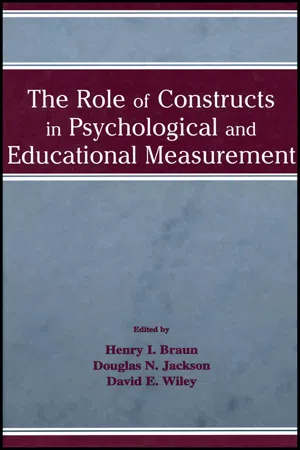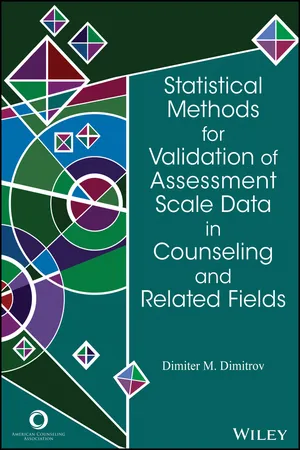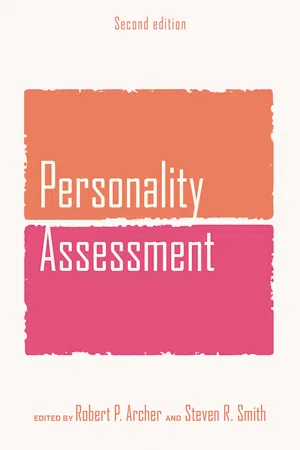Psychology
Personality Scales
Personality scales are assessment tools used to measure and quantify individual differences in personality traits. They typically consist of a series of questions or statements to which individuals respond, and the results are used to categorize and describe an individual's personality. These scales are widely used in psychological research and clinical practice to understand and evaluate personality characteristics.
Written by Perlego with AI-assistance
Related key terms
6 Key excerpts on "Personality Scales"
- Henry I. Braun, Douglas N. Jackson, David E. Wiley(Authors)
- 2001(Publication Date)
- Routledge(Publisher)
The meaning of personality assessment continues to be an important, unresolved issue, depending on one’s point of view. Personologists and many clinical psychologists continue to insist that one must know a great deal about an individual to truly understand his personality. Specific scale or factor scores are viewed as either irrelevant or too superficial to prove useful without a thorough analysis of an individual’s motivations, aspirations, history, and life circumstances. Although some personality measures may have a limited use to confirm personal impressions or to provide supplementary information, they are generally dismissed as incidental to a deep understanding of personality.Psychometrically oriented personality psychologists differ strongly with this idiographic point of view, insisting that a true science of personality must focus on measurement if any progress is to be made. The primary focus of scientific study should be the development of more reliable, valid measures of important aspects of personality that can then provide a stable framework within which to gain a deeper understanding of the individual.Many personality psychologists believe a stable framework is now at hand with the convergence of psychometric thinking on a hierarchical system dominated by the general Big Five factors. But such enthusiastic optimism is probably premature. There are good reasons why the idiographic-versus-nomothetic debate that raged vigorously in the 1960s has apparently faded away. Psychology has become more fragmented and compartmentalized with the growth in numbers, the diversity of research, and the proliferation of specialized societies and scholarly journals. Consequently, the many thousands of psychologists in applied settings who engage daily in personality appraisals for practical reasons have little discourse with the academic, psychometrically oriented psychologists engaged in personality research. Each group has a different mission and set of priorities that rarely meet. The fact that the issue has faded from the radar screen only means that the two groups have little more to say to each other at present.- eBook - ePub
- Dimiter M. Dimitrov(Author)
- 2014(Publication Date)
- American Counseling Association(Publisher)
Examples of binary scales for assessment in counseling include the following: (a) the Minnesota Multiphasic Personality Inventory—Second Edition (Butcher et al., 1989), a 56-item, true–false self-report inventory designed to assess major patterns of personality in adults aged 18–90 years; (b) the Substance Abuse Subtle Screening Inventory—3 (Miller & Lazowski, 1999), in which the scales consist of 67 true–false items regarding substance dependence; (c) the Jackson Personality Inventory—Revised (D. N. Jackson, 1997), an inventory of 300 true–false statements designed to measure 15 personality traits grouped into five higher order categories: Analytical, Emotional, Extroverted, Opportunistic, and Dependable; (d) Otis–Lennon School Ability Test (Otis & Lennon, 2004), a school ability test for students in Grades K–12 that includes seven levels (A–G), with binary scored items (1 = correct, 0 = incorrect) measuring five cognitive skills: verbal comprehension, verbal reasoning, pictorial reasoning, figural reasoning, and quantitative reasoning; and (e) TerraNova—Second Edition (CTB/McGraw-Hill, 2001), a multiple-skills test battery for students in Grades K–12 that uses binary scored multiple-choice items (1 = correct, 0 = incorrect) grouped into four scales to assess Reading/Language Arts, Mathematics, Science, and Social Studies (school systems can choose both multiple-choice items and constructed-response items).1.4.2 Rating Scales
A rating scale is represented by a set of ordered-category statements that express attitude, satisfaction, or perception about something (e.g., how often a specific behavior occurs). For each statement (scale item), the respondents are asked to select a category label from a list indicating the level of their attitude, satisfaction, or perception related to the statement. The numeric value associated with the category selected by a person represents the person's item score. The scale score for a person is obtained by summing (or averaging) the scores of that person on all individual items. Some clarifications on the legitimacy of summing (or averaging) scores are provided later in this chapter (Section 1.5.6). The most common examples of rating scales, Likert scale and Likert-type scale, are presented next.Likert Scale. The widely used Likert scales were developed by the American sociologist Rensis Likert (1903–1981). (Likert pronounced his name with a short i sound.) A distinction must be made first between a Likert scale and a Likert item. The Likert scale is the sum of responses on several Likert items, whereas a Likert item is a statement that the respondent is asked to evaluate according to (subjective or objective) criteria—usually, five levels of agreement or disagreement with the statement, where 1 = strongly disagree, 2 = disagree, 3 = neither agree nor disagree, 4 = agree, 5 = strongly agree - eBook - ePub
- Robert P. Archer, Steven R. Smith(Authors)
- 2014(Publication Date)
- Routledge(Publisher)
Introducing Personality AssessmentSTEVEN R. SMITHROBERT P. ARCHEROverview and Definition
“What is he like?” As social beings, we are continuously interested in the behavior and personality of those we meet. We are curious if someone is quiet, honest, proud, anxious, funny, indifferent, perceptive, or introspective. Those characteristics influence our experience of others and affect the quality of our relationships with them. When these characteristics persist to varying degrees over time and across circumstances, we tend to think of them as personality. Certainly, we informally evaluate others’ personalities all the time, but the clinical assessment of personality using psychometrically robust tools is an important component of the professional practice of psychology.When one speaks of personality assessment in psychology, activities include the diagnosis of mental illnesses, prediction of behavior, measurement of unconscious processes, and quantification of interpersonal styles and tendencies. Although all of these descriptions may be true for different clinicians working with various client groups, this listing may not accurately capture the full range of modern personality assessment. A general and encompassing definition is provided by Anastasi (1988): “A psychological test is essentially an objective and standardized measure of a sample of behavior” (p. 22). Some psychologists might find this definition too simplistic to capture the multitude of activities involved in assessment, and a broader definition has been proposed by Rorer (1990): - eBook - ePub
Personality
The Psychometric View
- Paul Kline(Author)
- 2013(Publication Date)
- Routledge(Publisher)
Chapter 2 Measurement of personality Personality tests Since the early days of psychology, there have been attempts to measure personality, with a variety of different kinds of tests. As a result of this considerable research effort, in the modern study of personality there are now three kinds of psychological test in general use: personality questionnaires or inventories (these terms are absolutely interchangeable); projective tests; and objective tests. Before describing these different types of personality tests, a few more general points about psychological measurement need to be made, thus enabling a fine examination of personality measurement. The characteristics of good psychological tests Psychometrics is the study of individual differences by means of psychological tests. Psychometricians, as specialists in measurement, attempt to produce tests with certain key features and these are set out below. They are the essentials of precise measurement and are thus critical for the proper application of the scientific method. All good tests should be highly reliable, valid, discriminating and have good norms. The meaning of these terms will now be discussed. To do this, however, a number of concepts require some explanation. Universe of items Any set of items in a test is assumed to be a random sample from a universe of relevant items. This universe is, of course, notional and infinite. The better the sample of items the better the test. The score on a psychological test is known as the obtained or the fallible score. This is to be distinguished from the true score. Any fallible score consists of true score + error. True score The true score consists of the score of a subject on the universe of items. This is, therefore, a notional score. However, as shall be seen, it can be estimated from the obtained or fallible score provided that the reliability of the test is known - Keith Coaley(Author)
- 2014(Publication Date)
- SAGE Publications Ltd(Publisher)
In this section we have explored attitudes, how they are defined and how they can be measured. Key factors are that they tend to be consistent, are related to a person’s feelings, and have importance, focus and intensity for the individual. Although they have been defined in different ways, they are thought to represent predispositions to behave in particular ways towards some stimulus. A number of measurement techniques and scales have been developed for their assessment, including Thurstone’s and Likert’s scales, Guttman’s Scalogram and the semantic differential.WHAT HAVE WE DISCOVERED ABOUT THE BASIC COMPONENTS OF ASSESSMENT?This chapter has focused upon the two things said to be the basic components of psychological assessment and measurement, i.e. scales and items. We have seen how different types of item can be constructed and that through the use of scaling individuals’ responses can be transformed into quantitative measurements. We have also seen how analysis can be made of the effectiveness of the items which go to make up a measure, including such aspects as their difficulty and their discrimination between responses. Analytical approaches have advanced substantially over the years, especially through the development of computer technology and mathematical modelling. The specific applications of measurement techniques to the study of attitudes have also been examined. We have learned about:- eBook - ePub
Modern Psychometrics
The Science of Psychological Assessment
- John Rust, Michal Kosinski, David Stillwell(Authors)
- 2020(Publication Date)
- Routledge(Publisher)
For example, if a person obtains a score of 3 on a 24-point scale of introversion/extraversion, with a low score representing introversion, a high score representing extraversion, and a cutoff point of 12 that divides them, then there is a high probability that they actually are an introvert type, and a low probability that they actually are an extravert type. A score of 12 shows that they have an equal probability of being either an introvert type or an extravert type. For those with a score of 11, there is a slightly higher probability that they are an introvert type than an extravert type. Thus, a person’s score on any extraversion scale may be used to represent their position along an introversion–extraversion dimension (trait) or as an indication of the probability that the person is an extravert or an introvert (type). In practice, however, scores on type measures are collapsed so that people are categorized as belonging to either the introvert or the extravert type.Different approaches to personality assessment
Self-report techniques and personality profiles
Self-report inventories comprise a series of items to which individuals respond according to how they view themselves. Questionnaires such as the 16PF (16 personality factor questionnaire, Cattell, 1957 ) and the OPP (Occupational Personality Profile, Saville et al., 1984 ) are the most widely used self-report measures and are available for online administration, although computerized and paper-and-pencil versions are sometimes preferred. The Orpheus Business Personality Inventory (OBPI; Rust, 2019 ), a work-based assessment of five personality traits and seven integrity traits, is another example. The advantages of self-report inventories are:• They are quick and easy to administer. • Scoring is objective. • Responses are obtained directly from the person being assessed.The limitations are:• The respondents may not have good insight about themselves. • They may try to present themselves in the best possible light. • They may try to present themselves according to what they think is expected or desired. • It is difficult to know whether the questionnaire has been completed with due care and attention.The results of self-report psychometric personality tests are normally reported as a personality profile. Within a profile (rather than one test score), many subtest scores are presented, but in such a way that they can be compared with each other. There can often be items from as many as 20 subscales existing in one personality test, with their items randomly interspersed—the items only being brought together for scoring purposes. The raw item responses and raw scores are then standardized; the standardized subscale scores are illustrated as a profile, which will have a subscale score as one axis—usually with stanine scores ranging from 1 to 9, with 5 as the midpoint—and the various subscales laid out along the other axis. An example of a profile is given in Figure 6.1
Learn about this page
Index pages curate the most relevant extracts from our library of academic textbooks. They’ve been created using an in-house natural language model (NLM), each adding context and meaning to key research topics.





